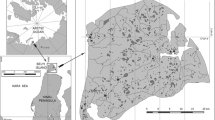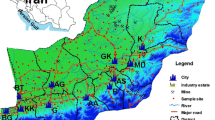Abstract
Purpose
Association of element concentrations for the escarpment soils of northeastern North Dakota formed from different geologic parent materials was determined based on geochemical data. These soils overlie the Cretaceous Pierre Formation, and parent materials consist of shale rich glacial till, residual shale, and colluvial materials.
Materials and methods
Samples were analyzed for cadmium and other trace elements using nitric acid digestion followed by optical emission spectroscopy. Morphologic and laboratory analysis of soil cores indicate high clay content, indicative of the influence of shale residuum on the parent materials of the escarpment soils.
Results and discussion
An average, cadmium concentration of 0.24 ± 0.22 mg/kg was determined for 136 samples from eight (approx. 2.4 m deep) cores. The concentration of molybdenum had a range between 0.00 and 7.99 mg/kg. Zinc levels determined in the samples had a wide range between 18.76 and 128.02 mg/kg. Principal component analysis revealed that elevated trace element concentrations for the shale-rich portion of the soils in northeastern North Dakota are linked to a variety of factors including organic matter content, pH, elevation, and electrical conductivity.
Conclusions
Results of this study suggest that erosion and transport of Cretaceous shales downslope on the escarpment have resulted in enriched trace element concentrations in the soils.





Similar content being viewed by others
References
Adriano DC (1986) Trace elements in terrestrial environments: biogeochemistry, bioavailability and risks of metals, 2nd edn. Springer, New York
Alloway BJ (1990) Heavy metals in soils, 2nd edn. Blackey Academic and Professional. Chapman and Hall, Glasgow
Alloway BJ, Tills AR, Morgan H (1985) The speciation and availability of cadmium and lead in polluted soils. Tr Sub Environ 18:187–201
Andersson A (1977) Heavy metals in Swedish soils: on their retention, distribution and amounts. Swed J Agric Res 7:7–20
Aoyama I (1982) Local redistribution and partial extraction of heavy metals in sediments of an estuary. Environ Pollut B4:27–34
Arndt BM (1975) Geology of Cavalier and Pembina Counties. County groundwater studies part 1. North Dakota Geological Survey, Bismarck
Bluemle JP (2000) The face of North Dakota, 3rd edn. North Dakota Geological Survey. Bismarck
Brantley SL, Lebedeva M (2011) Learning to read the chemistry of regolith to understand the critical zone. Annu Rev Earth Planet Sci 39:387–416
Burau RG, Kalita KY, Inouye TS, Miller M (1973) Chemical analysis of soil samples from the Salinas Valley, California for cadmium, zinc and phosphate. Report to State Water Resources Control Board. University of California, Davis
Cavallaro N, McBride MB (1980) Activities of Cu2+ and Cd2+ in soil solutions as affected by pH. Soil Sci Soc Am J 44:729–732
Cheng CH, Jien SH, Tsai H, Chang YH, Chen YC, Hseu ZY (2009) Geochemical element differentiation in serpentine soils from the Oophilitic Complexes, Eastern Taiwan. Soil Sci 174(5):283–291
Combs SM, Nathan MV (1998) Soil organic matter. In: Recommended chemical soil test procedures for the North Central Region. Missouri Agricultural Experiment Station SB 1001. Columbia
Comis D (1995) Getting cadmium out of sunflower seeds. Agric Res Mag 43:21
Cornelis C, Geuzens P, Corthouts V, Van Den Broeck H (1993) Achtergrondgehalten van een aantal anorganische en organische verontreinigingen in Vlaamse bodems, Voorstel voor referentiewaarden. Deelrapport 3 MIE/DI/9327, VITO, Mol, Belgium
Eberl DD, Smith DB (2009) Mineralogy of soils from two continental-scale transects across the United States and Canada and its relation to soil geochemistry and climate. Appl Geochem 24:1394–1404
Erickson ML, Barnes RJ (2005) Glacial sediment causing regional-scale elevated arsenic in drinking water. Ground Water 43(6):796–805
Fang W, Hu R, Wu P (2002) Influence of black shale on soils and edible plants in the Ankang area, Shaanxi Province, P.R. of China. Environ Geochem Health 24:35–46
Franzen DW, Nanna T, Norvell WA (2006) A survey of soil attributes in North Dakota by landscape position. Agron J 98(4):1015–1022
Garcia JH, Li WW, Arimoto R, Okrasinski R, Greenlee J, Walton J (2004) Characterization and implication of potential fugitive dust sources in the Pasodel Norte region. Sci Total Environ 325(1–3):95–112
Garrett RG (1994) The distribution of cadmium in A horizon soils in the prairies of Canada and adjoining United States. Geol Surv Can, Current Research 1994-B 73–82
Gill J, Cobban WA (1965) Stratigraphy of the Pierre Shale, Valley City and Pembina Mountain areas North Dakota. USGS Prof. Paper A392, 20. United States Government Printing Office, Washington DC
Griffin RA, Au AK, Frost RR (1977) Effect of pH on adsorption of chromium from landfill leachate by clay minerals. J Environ Sci Health A 12:431–449
Haas CN, Horowitz ND (1986) Adsorption of cadmium to kaolinite in the presence of organic material. Water Air Soil Pollut 27:131–140
Harter RD (1983) Effect of soil pH on adsorption of lead, copper, zinc and nickel. Soil Sci Soc Am J 47:47–51
Holmgren GG, Meyer MW, Chaney RL, Daniels RB (1993) Cadmium, lead, zinc, copper, and nickel in agricultural soils of the United State of America. J Environ Qual 22:335–348
Hopkins DG, Norvell WA, Wu J (1999) Formation and distribution of trace-element-enriched soils near the Pembina Escarpment, Cavalier County, North Dakota. Proc. 91st ND Acad. Sci., Grand Forks, ND
Horckmans L, Swennen R, Deckers J, Maquil R (2005) Local background concentrations of trace elements in soils: a case study in the Grand Duchy of Luxembourg. Catena 59:279–304
Jacob D, Yellick A, Kissoon L, Asgary A, Wijeyaratne D, Saini-Eidukat B, Otte ML (2013) Cadmium and associated metals in soils and sediments of wetlands across the Northern Plains, USA. Environ Pollut 178:211–219
Jenne EA (1968) Control of Mn, Fe, Co, Ni, Cu and Zn concentrations in soils and water—the dominant role of hydrous manganese and iron oxides. Adv Inorg Chem 7:337–387
Jyoti V (2010) Trace element distribution in soils of the Pembina Escarpment, North Dakota. M.S. thesis, North Dakota State University, 168 pp
Khan S, Nonden D, Khan NN (1982) The mobility of some heavy metals through Indian red soil. Environ Pollut Ser B 4:119–125
Kim KW, Thornton I (1993) Influence of Ordovician uraniferous black shales on the trace element composition of soils and food crops, Korea. Appl Geochem 8(2):249–255
Kingston HM (1997) Microwave assisted acid digestion of sediments, sludges, soils and oils. In: SW 846 test methods for evaluating solid waste, physical/chemical methods 2nd edn. US Environmental Protection Agency, Washington, DC
Kippler M, Tofail F, Hamadani JD, Gardner RM, Grantham-McGregor SM, Bottai M, Vahter M (2012) Early-life cadmium exposure and child development in 5-year old girls and boys: a cohort study in rural Bangladesh. Environ Health Perspect 120:1462–1468
Klassen RA (2009) Geological controls on soil parent material geochemistry along a northern Manitoba–North Dakota transect. Appl Geochem 24(8):1382–1393
Lawrence FW, Upchurch SB (1982) Identification of recharge areas using geochemical factor analysis. Ground Water 20:680–687
Lee J-S, Chon H-T, Kim K-W (1998a) Migration and dispersion of trace elements in the rock–soil–plant system in areas underlain by black shales and slates of the Okchon Zone, Korea. J Geochem Explor 65:61–78
Lee J-S, Chon H-T, Kim J-S, Kim K-W, Moon H-S (1998b) Enrichment of potentially toxic elements in areas underlain by black shales and slates in Korea. Environ Geochem Health 20:135–147
Li YM, Stanislavova L, Chaney RL (1994) Determination of total cadmium in calcareous soils by extraction using Aliquat-336 and 3-heptan-one after aqua regia digestion. Commun Soil Sci Plant Anal 25:2029–2045
Lund LJ, Betty EE, Page AL, Elliot RA (1981) Occurrence of naturally high cadmium levels and its accumulation by vegetation. J Environ Qual 10:551–555
McBride MB (1977) Copper (II) interaction with kaolinite factors controlling adsorption. Clay Clay Miner 26:101–106
McLean JE, Bledsoe BE (1992) Behavior of metals in soils. Ground water issue. USEPA, EPA/540/S-92/018
Miller RW, Gardiner DT (2000) Soils in our environment, 9th edn. Prentice Hall, New Jersey
Mitchell RL (1974) Trace element problems in Scottish soils. Neth J Agric Sci 22:295–304
NCDC (2010) National Climatic Data Center. Ashville, North Carolina. http://www.ndsu.edu/ndsco/climatography/lang.pdf./ accessed Aug 2010
NDAWN (2010) North Dakota Agricultural Weather Network. Fargo, North Dakota. http://ndawn.ndsu.nodak.edu/index.html accessed Aug 2010
Neal RH, Sposito G, Holtzclaw KM, Trania SJ (1987) Selenite adsorption on alluvial soils: I soil composition and pH effects. Soil Sci Soc Am J 51:1161–1165
Nowak B (1998) Contents and relationship of elements in human hair for a non-industrialized population in Poland. Sci Total Environ 209:59Y68
Page AL, Chang AC, El-Amamy M (1987) Cadmium levels in soils and crops in the United States. In: Hutchinson TC, Meema KM (eds) Lead, mercury, cadmium and arsenic in the environment, ch. 10. Wiley, New York, pp 119–146
Satarug S, Garrett SH, Sens MA, Sens DA (2010) Cadmium, environmental exposure and heath outcomes. Environ Health Perspect 118:182–190
Schultz LG, Tourtelot HA, Gill JR, Boerngen JG (1980) Composition and properties of the pierre shale and equivalent rocks, Northern Great Plains Region. US Geol. Surv. Prof. Paper B1064. United States Government Printing Office, Washington DC
Shacklette HT, Boerngen JG (1984) Element concentrations in soils and other surficial materials of the conterminous United States. US Geol. Surv. Prof. Paper 1270
Simmons M, Moos DK (1990) Soil survey of Cavalier County, North Dakota. United States Government Printing Office, Washington DC
Smith RE, Michalyna G, Wilson G (1973) Soils of the Morden–Winkler area. Soils report 18. Manitoba Dept. of Agric. Winnipeg
Smith DB, Cannon WF, Woodruff LG, Garrett RG, Klassen R, Kilburn JE, Horton JD, King HD, Goldhaber MB, Morrison JM (2005) Major- and trace element concentrations in soils from two continental-scale transects of the United States and Canada. US Geol Surv Open-File Rep. #1253. http://pubs.usgs.gov/of/2005/1253/
Smith DB, Woodruff LG, O’Leary RM, Cannon WF, Garrett RG, Kilburn JE, Goldhaber MB (2009) Pilot studies for the North American Soil Geochemical Landscapes Project—site selection, sampling protocols, analytical methods, and quality control protocols. Appl Geochem 24(8):1357–1368
Smith DB, Cannon WF, Woodruff LG, Solano F, Kilburn JE, Fey DL (2013) Geochemical and mineralogical data for soils of the conterminous United States. US Geological Survey Data Series 801, 19 p., http://pubs.usgs.gov/ds/801/
Smith DB, Cannon WF, Woodruff LG, Solano F, Ellefson KJ (2014). Geochemical and mineralogical maps for soils of the conterminous United States. US Geological Survey. Open File Report #2014-1082. http://pubs.usgs.gov/of/2014/1082/
Storer DA (1984) A simple high sample volume ashing procedure for determination of soil organic matter. Soil Sci Plant Anal 15(7):759–772
Tuttle MLW, Breit GN, Goldhaber MB (2009) Weathering of the New Albany Shale, Kentucky: II. Redistribution of minor and trace elements. Appl Geochem 24:1565–1578
Watson ME, Brown JR (1998) pH and lime requirement. In: Recommended chemical soil test procedures for the North Central Region. Missouri Agricultural Experiment Station SB 1001. Columbia
White JG, Welch RM, Norvell WA (1997) Soil zinc map using geostatistics and geographic information systems. Soil Sci Soc Am J 61:185–194
Whitney DA (1998) Soil salinity. In: Recommended chemical soil test procedures for the North Central Region. Missouri Agricultural Experiment Station SB 1001. Columbia
Woodruff LG, Cannon WF, Eberl DD, Smith DB, Kilburn JE, Horton JD, Garrett RG, Klassen R (2009) Continental-scale patterns in soil geochemistry and mineralogy: results from two transects across the United States and Canada. Appl Geochem 24(8):1369–1381
Acknowledgments
The project described was supported by NIH Grant Number P20 RR016471 from the INBRE Program of the National Center for Research Resources, USDA/NIFA, and the North Dakota Agricultural Experiment Station. Its contents are solely the responsibility of the authors and do not necessarily represent the official views of NIH. D. Sens and D. P. Schwert are gratefully acknowledged for their support. M. Ginsbach assisted with core descriptions. Ted Feit assisted in multi-element analysis. M. Otte and D. Jacob of the WERG lab at NDSU are thanked for their analytical support.
Author information
Authors and Affiliations
Corresponding author
Additional information
Responsible editor: Dong-Mei Zhou
Electronic supplementary material
Below is the link to the electronic supplementary material.
Table A.1
(DOCX 30 kb)
Rights and permissions
About this article
Cite this article
Jyoti, V., Saini-Eidukat, B., Hopkins, D. et al. Naturally elevated metal contents of soils in northeastern North Dakota, USA, with a focus on cadmium. J Soils Sediments 15, 1571–1583 (2015). https://doi.org/10.1007/s11368-015-1122-6
Received:
Accepted:
Published:
Issue Date:
DOI: https://doi.org/10.1007/s11368-015-1122-6




